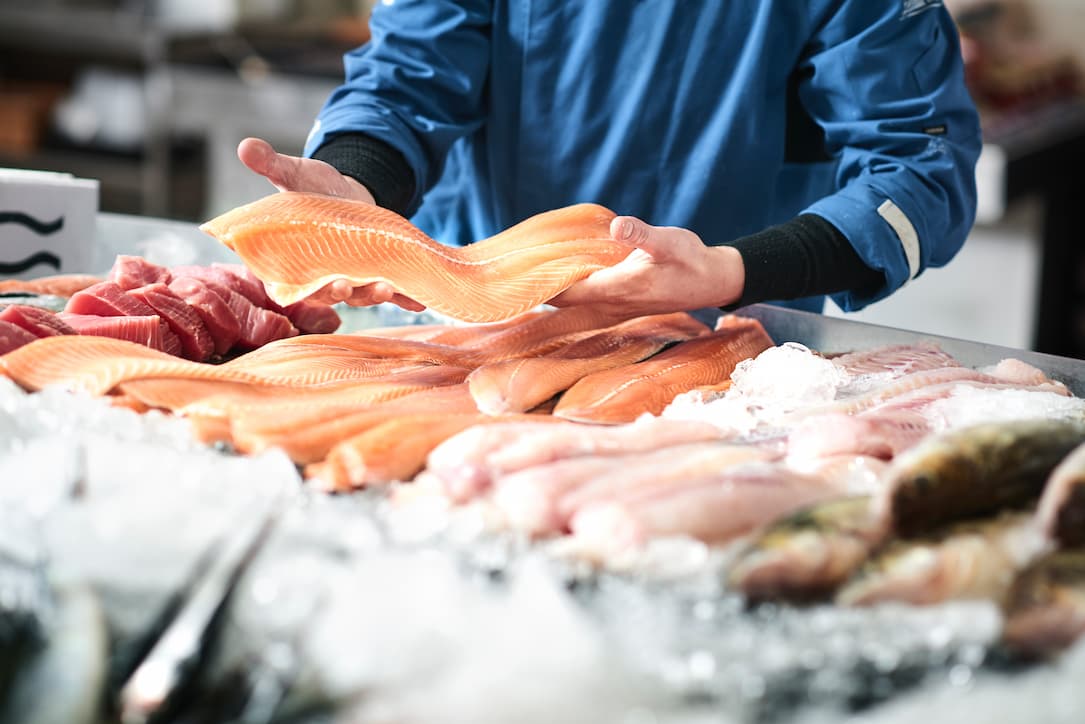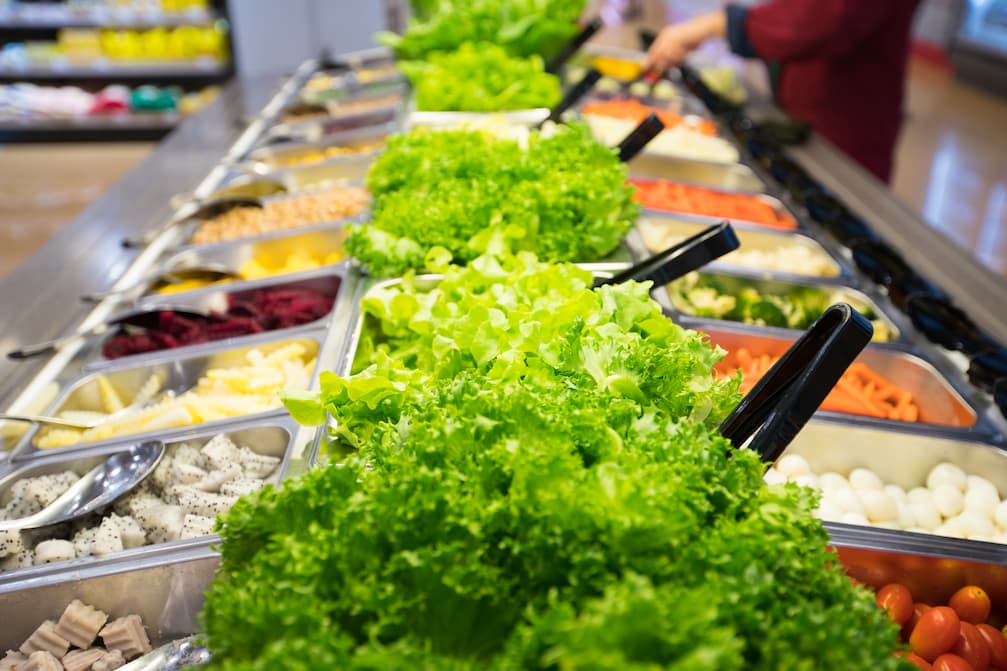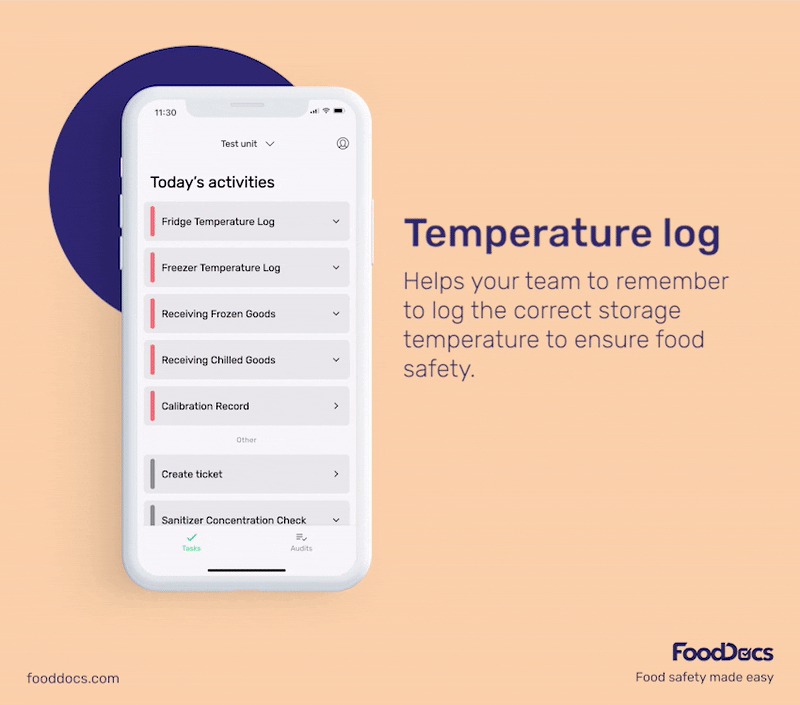Why Is Food Safety Important In Healthcare? Healthcare Leaders Guide
Learn challenges healthcare foodservice teams face today and key food safety practices to protect vulnerable patients. Get a free healthcare leader...
Not all foods are best served when hot or warm. Some foods, such as salads or sushi, are more appealing when served chilled or cold. In addition, some raw materials, such as raw fish and different types of seafood, are often displayed on ice when on sale.
This display type allows consumers to see the food up close and inspect the raw materials. Low-temperature storage can be an effective way to display foods while keeping their freshness and safety control.
When you display food on ice, you must keep the food at or below 41°F (5°C) to prevent bacteria growth and maintain freshness. You should also display the food on clean, food-grade ice to avoid contamination.
WHAT WE'LL COVER:
Foods displayed on ice are exposed to several risks of food contamination. The preservation method of subjecting foods to low temperatures can help reduce these risks and allow customers to enjoy chilled foods or fresh raw ingredients at any time.
When you display food on ice, the food must be at least 41°F (5°C) or below to remain safe and fresh. The effectiveness of low-temperature storage lies in the precision of maintaining the ideal food safety temperature.
Low-temperature or cold storage extends the freshness of foods. That includes both safety and quality aspects. Some foods are purposefully displayed on ice to allow inspection. During this storage, foods are in containers and are surrounded by ice. The storage area temperature is then consistently controlled.
This method acts similar to refrigeration but with an open system. It is often done on salad bars to prevent vegetables and fruit from losing their freshness and for fish and seafood.
Such a principle is used for refrigeration and freezing inside units used to cool foods. Refrigeration runs at 41°F (5°C) or below. At this temperature, the biological functions of the food, as well as any potentially present foodborne bacteria, are slowed down. A cold environment for bacteria can stop their harmful processes.
On the other hand, the freezer temperature works at 0° F (-18° C). Freezing completely stops the growth of foodborne bacteria and other pathogens. In fact, it can sometimes injure dangerous bacteria and lower amounts of bacteria. Despite this, freezing food is not a kill step for pathogens. Frozen food has a longer shelf life but can still spoil once thawed.
Use our Proper Food Storage Chart to identify how refrigeration and freezing affect the shelf-life of foods.

When you use ice to keep food cold, you can know if the food is at the correct temperature by using a thermometer.
Displaying food on ice is a common food safety practice for restaurants, retail food stores, and other food establishments that serve fresh foods. Some products that can be displayed on ice include beverages, salads, desserts, and even deli or raw meat.
Restaurants and other food businesses display food on ice for better presentation and allow customers to see what they buy. This method is a great strategy to show what your business offers and for serving fresh and vibrant, cold food.
Below are three main advantages of displaying food on ice:
The key to achieving these advantages of displaying foods on ice is consistent monitoring of the temperature.When food handlers regularly monitor the storage temperature, they can easily apply corrective actions in case of non-compliance. This is the main cold food storage rule.
Temperature monitoring is part of a food safety management system, and forgetting to do it may cost you the safety of your food and can make people sick. Inconsistent monitoring of storage temperature can lead to producing harmful foods.
Need a smart solution? At FoodDocs, our Food Safety Management software can help you never miss monitoring your storage temperature and fulfill all other food safety tasks on time. With our digital solution, you can get digital monitoring forms with a smart notification system that will remind you whenever it's time to check your ice display temperature.
A food display refrigerator is a type of cooling unit used in restaurants that features an open-view facade for displaying foods. This type of cooling equipment is often composed of multiple shelves that can hold large amounts of food and a temperature regulator to cool food.
This equipment is often used in cafes and deli meat stores for displaying foods that require temperature regulation. A food display refrigerator has open-back access to allow food handlers to retrieve food. It is often used on buffet lines in restaurants.
Depending on the intended food to be displayed, a food display refrigerator can come with attachments that allow the holding of ice and containers for food. This equipment also has a more regulated temperature function than simply displaying foods on ice.
Other food manufacturers and food retailers use a variant of this equipment, which is a countertop refrigerated display case. This variant can fit countertop tables and can be used for smaller displays.
Kinds of foods such as salad ingredients, including fresh produce vegetables and fruits, fish, seafood, and desserts, are often displayed on ice. Some of these food items can be set directly on ice, such as in the case of raw fish or prepared dishes, including sashimi and sushi, which are types of ready-to-eat food. Other foods displayed on ice are placed in a shallow container and submerged to the level of the ice.
Restaurants offer food displayed on ice as a method of widening the menu variety. A refrigerated display can allow a food business to offer fresh salads with a very wide selection. Additionally, this method is a great alternative for serving foods such as sushi and other raw meats without preparing them on the spot.

As a rule, salad bar temperatures in buffet tables must be maintained at 41°F (5°C) or below. This food temperature range is effective in prolonging the safety of any high-risk food in salad bars.
High-risk TCS foods (time/temperature control for safety), when left within the temperature danger zone, can spoil as fast as 2 hours and become hazardous foods. This temperature range is optimal for the growth of harmful bacteria and spoilage of foods. When foods are stored at refrigerated temperatures during display, they can stay fresh for extended periods. Your team can be sure that the risk of causing food poisoning or a foodborne outbreak is limited.
Maintenance of what temperature should a salad bar be kept at can be achieved using a properly calibrated thermostat or a food thermometer. Food handlers must consistently monitor the temperature of the salad bar to ensure food safety.
Record information for your kitchen thermometer calibration using our Thermometer Calibration Log.
The amount of ice required for a salad bar is approximately 30-35 pounds per cubic foot.
While low-temperature storage is an effective method of keeping foods safe, it can still be contaminated. Precautions and proper food handling must be practiced to make the operation effective for your products.
When storing products and keeping food cold, it is important to follow these few steps:
Follow these tips when displaying foods on ice for better service and to prevent experiencing any food code violations. Make these tips a part of your daily checklist or incorporate them into your food safety management system. You can do that when you use our versatile and customizable digital Food Safety Management System at FoodDocs. Using artificial intelligence, our system can automatically generate the most significant monitoring logs and checklists for your food manufacturing operations. Food business employees can further customize these documents to fit your business even more.
Like any other method of food storage, controlled temperature storage, such as in displaying foods on ice, requires intensive and consistent monitoring to become effective. If food handlers forget to monitor the display temperature and foods are exposed to ambient temperature for extended periods of time, food safety can be critically compromised by rapid bacteria growth.
A pen-and-paper food safety management system can be very thorough, but food service operators can still forget to measure the temperature of your display. It is human nature sometimes to forget tasks, which can damage your business.
What you need is the aid of an intuitive solution. At FoodDocs, we can provide you with a digital solution that covers all food safety tasks and can even help food handlers create a more efficient food safety system for everyday compliance.

Using our digital Food Safety Management System, you can get the following benefits for the improvement of your operation's maximum efficiency:

In addition to digital solutions for food workers, our digital FSMS can also help managers improve the efficiency of overseeing the entire operation system:
Switching to our digital platform only requires a total of 15 minutes of your time. Yes, you read that correctly. Setting up our digital Food Safety Management System can be done at any time of the day and can be immediately implemented afterward.
All you need to do is answer a few basic questions about your operations. Our system will automatically generate a complete digital FSMS for you using artificial intelligence and a machine-learning program. You can further customize sections to fit your operations or improve them after a food safety inspection from your health department.
When you switch to a digital platform, there is no more need to print out your monitoring logs and other food safety documents. This platform is also your first step to becoming a more sustainable food company.
Start your food safety compliance journey with us at FoodDocs starting your a 14-day free trial.
Learn challenges healthcare foodservice teams face today and key food safety practices to protect vulnerable patients. Get a free healthcare leader...
Learn what Standard Operating Procedures (SOPs) are and how to write effective SOPs that ensure consistency, efficiency, and safety in your...
Boost your retail food safety with essential practices and digital tools to protect customers and your brand. Plus a free Retail Food Safety Leader...